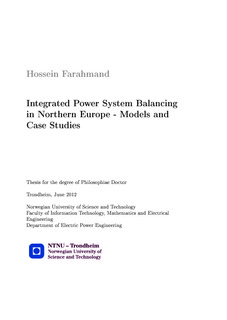| dc.description.abstract | Maintaining a continuous balance between generation and load is crucial for the safeguarding of the power systems. In order to effectively deal with the various uncertainties that contribute to the real-time imbalance in liberalised power systems, Transmission System Operators (TSOs) procure and employ the so-called balancing services through balancing markets. In Europe, though such mechanisms are well in place at the national level, the potential of multinational balancing markets has not been fully exploited (with the exception of the Nordic system and various pilot projects). This thesis analyses the potential for integrating the balancing power markets in northern Europe, including the Nordic system, Germany and the Netherlands. It addresses the twin issues of the procurement and employment of cross-border balancing services by using mathematical models.
Beginning with an outline of the role of balancing markets in Europe, an overview of existing balancing markets in the northern European system is presented. A discussion on the cross-border balancing arrangements is then carried out, paving the way for quantitative analysis. A quantitative analyses of the multinational balancing markets are carried out, both in terms of attainable socio-economic cost savings, and their effect on the exchange of regional balancing services and generation dispatch. In this respect, two cases of balancing market integration are analysed: the current state with separate balancing markets, and the anticipated state of full integration of these markets.
In the proposed modelling approach a two-step model is used, representing the day-ahead and balancing markets, respectively. First, the day-ahead market is modelled as a common market for the whole European continent. Simultaneously, reserve procurement for northern Europe is modelled. Available transmission capacity is allocated implicitly to the balancing services exchange, based on the trade-off between day-ahead energy and balancing capacity exchange. Next, the balancing energy market is modelled as a real-time power dispatch on the basis of the day-ahead market clearing results and simulated imbalances. Detailed results illustrate the consequences of market integration between two synchronous areas on procured and activated reserves, dispatch of generators, and power flows. The profitability of balancing market integration is quantified by the observed cost savings obtained due to the use of cheaper balancing resources and less activation of reserves caused by imbalance netting.
The implementation of cross-border balancing entails both qualitative and quantitative analyses of different balancing exchange scenarios. This thesis focuses on the qualitative studies of cross-border balancing arrangements together with the quantitative analysis of cross-border balancing. The methodology developed in the thesis enables the study of the benefits of integrating the northern European balancing markets, and the resulting exchange of balancing services among the Nordic countries, Germany and the Netherlands. The multinational balancing market can be adapted to capture the effect of different market integration scenarios. The presented modelling approach includes a flow-based market model, which takes into account physical power flows and loop flows, especially suitable for the European systems with highly meshed transmission grids.
A four tiered sequential approach is used to organize the primary contributions of the research work, as highlighted by the four distinct publications arising out of it.
Tier 1: An optimal methodology for reserve activation in the Nordic system is established.Tier 2: Using the first tier as the basis, a cross-border reserves procurement algorithm is proposed for an integrated European system.
Superimposing Tier 2 on Tier 1 results in a bottom-up approach of capturing the full spectrum of reserve procurement and activation for integrated balancing markets.
Tier 3: The profitability of balancing market integration is brought forward through both weekly and yearly analysis on the basis of mathematical models developed in Tier 1 and 2.Tier 4: It is shown that the flexibility concerns warranted by penetration of renewable energy resources can be well addressed by using the developed framework of cross-border balancing market integration. A case study of a future power system (in 2030) with wind energy penetration has been employed in this regard.
The results include the optimal distribution of balancing reserve capacity allocations for procurement among the constituent countries, and the optimal exchange of balancing energy that ensues upon activating these capacity reserves.
An annual analysis of the post-integration scenario results demonstrates the significant cost savings that are achievable under the framework of multinational balancing markets.
The results also demonstrate the potential for increased production flexibility, in light of increased wind energy penetration in the future operation of power systems through the mechanism of multinational balancing markets.
| nb_NO |
